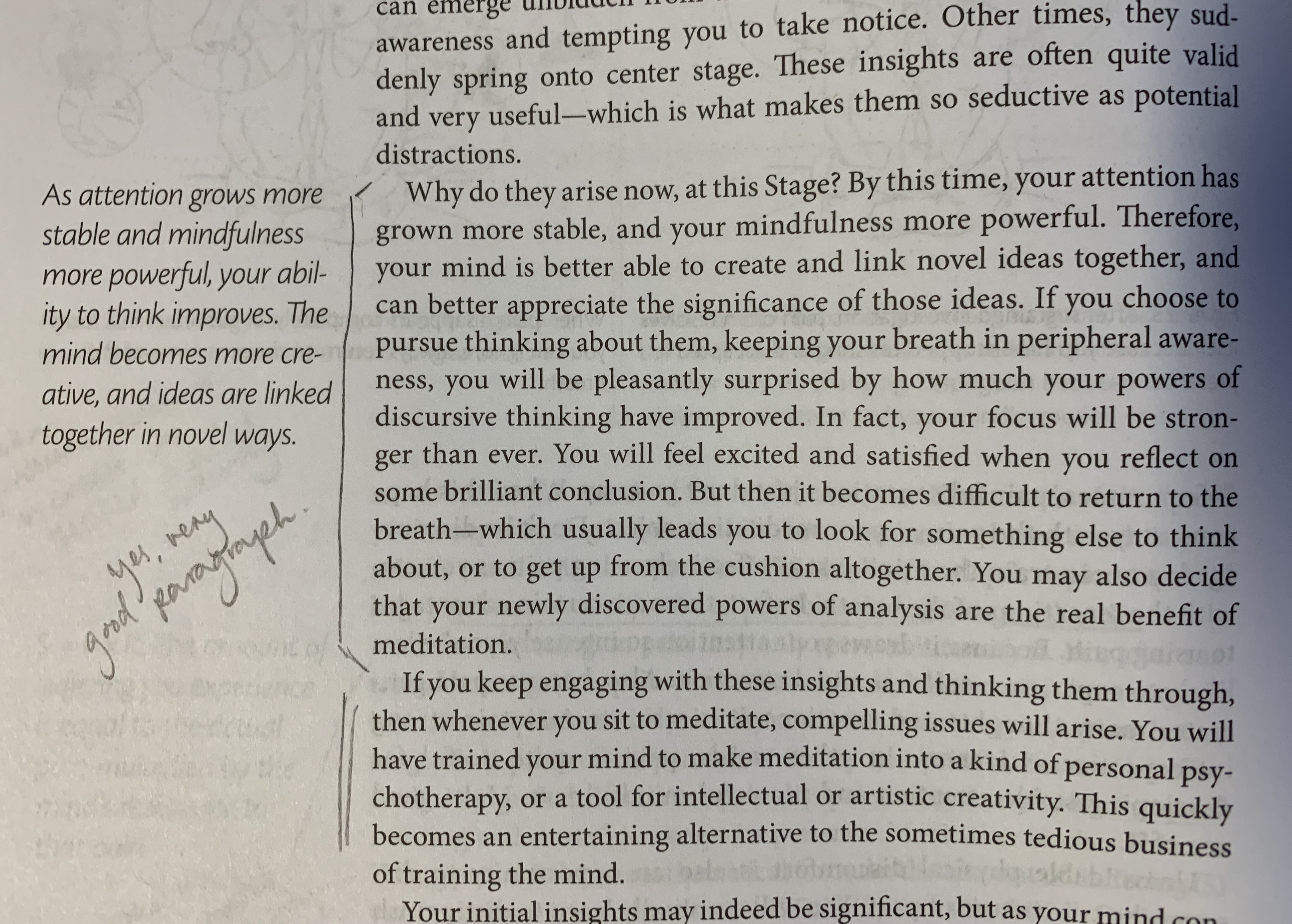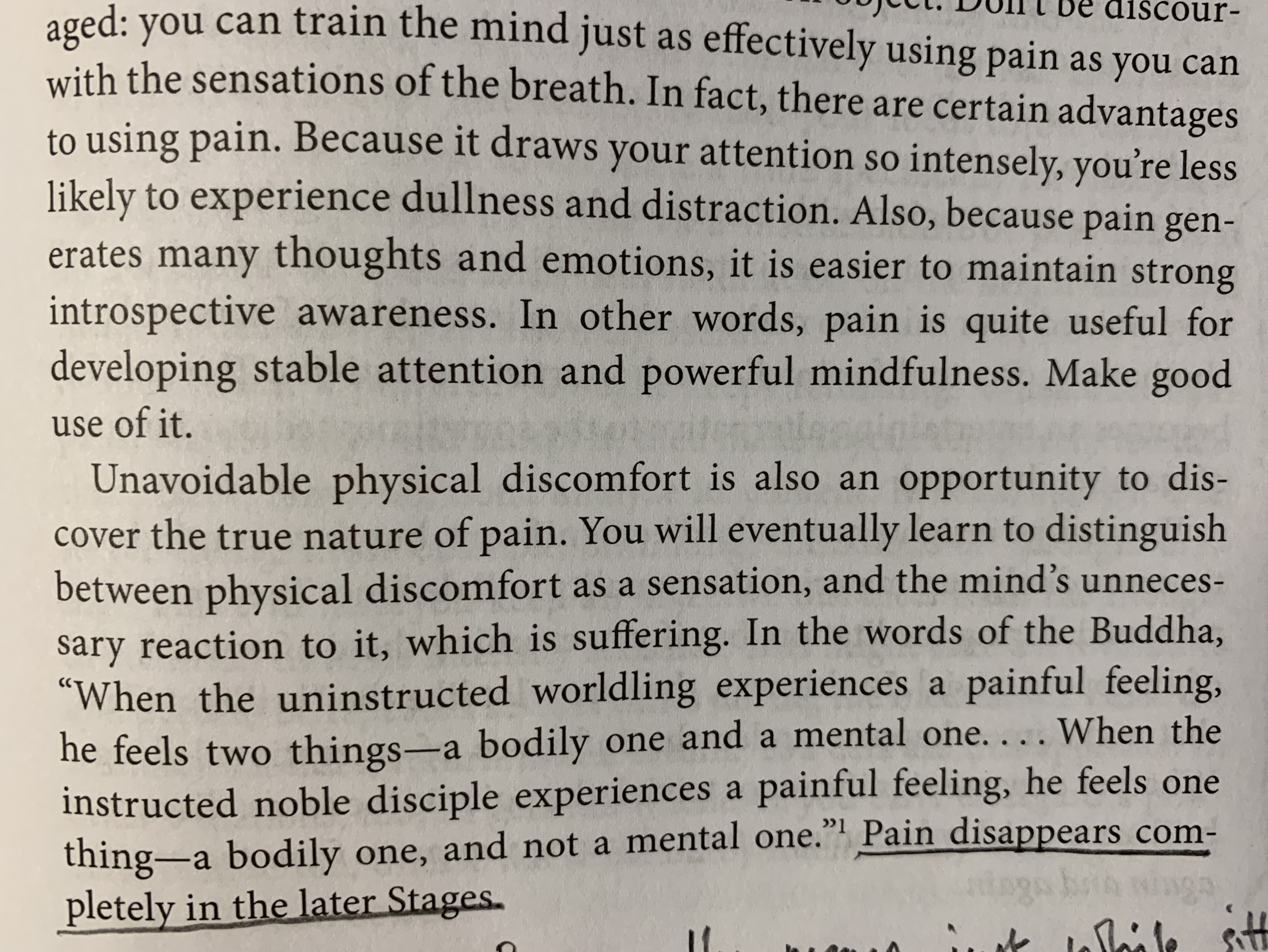
The Mind Illuminated, stage 4: p. 132
These are reflective notes on my experience of practicing Culadasa’s 10 stage meditation system. The notes in this post are from my eighth day of practice in the system. For an introduction to this project, see this page. Occasionally I will post-edit the journal. Any post-editing is [in square brackets like this].
Day 8
1hr sit:
- Sat in quiet focus, maintained attention to breath and peripheral awareness.
- A few images arose, labelled them, noticed they were memories of negative experience, didn’t have any particular reaction to them, just saw them & maintained focus on the breath.
- Some pleasant physical sensations arose at skin level, let them be, didn’t interact with them mentally.
- There was an argument on the road outside. (This is unusual - I live in the countryside, the road is about 30 yards down a hill. The sound of occasional cars comes up to the house, but not loud.) The voices were clear, transparent and kind of distant. I could hear the sounds of the words, but they had no conceptual meaning, it was like hearing a stream babble.
- Generally quiet, noticing the detail of breath to a greater extent than previously, maintained awareness throughout.
- Towards the end of the hour, noticed dullness encroaching, put more effort into breath concentration & the dullness went away.
The hard distinction between the breath in the foreground with a background of awareness was much softer after I intentionally raised the peripheral awareness level. This practice resembled a preparation practice for shi-ne meditation.
Today I read the chapter on stage 4 in the book. The suggestion is to ignore pain for as long as possible, then investigate pain by asking questions. I previously wrote about attitudes towards pain in meditation on day 6.

The Mind Illuminated, stage 4: p. 131
In samatha-vipassana, ignoring pain is methodologically true to the traditional Sutric worldview: that we are the cause of our own pain, physical, emotional and mental. We can intervene in the continuing cycle of causation by, eventually, stopping the experience of sensation. The first step towards this is separating our mind from the painful cycle of causation (by ignoring/renouncing it).
The benefit of this approach is that it gives us access to a new, non-ordinary way to relate to pain. The results can be unexpected: acute, long-standing pain might dissipate on its own, or pain might change from excruciating to a shimmering kind of pleasurable sensation. Not only our relationship with pain, but our very idea of what it is, can loosen up for the better.
One downside is that ignoring pain risks cultivating contempt of being. This is in keeping with Buddhist traditions whose final achievement was not-being and is, indeed, characteristic of many revered Buddhist sutras. However, it’s problematic for many contemporary practitioners who want to appreciate life more, not less.
Another less obvious risk is that ignoring pain and other sensations creates an artificial mind-body split. We begin to inhabit the mind part of our existence to the exclusion and rejection of our embodied experience. Worse, we risk imposing unnatural expectations on our physicality and emotions, which can lead to uncontrolled backfiring later on.
[Post-edit, for clarity: I’m willing to sit through discomfort and regard that as a necessary stage of training. I’ve also had experiences of sitting through acute, physical pain and experiencing the sensation change in non-ordinary ways. Vajrayana has transformative and liberating methods for working with sensation, including pain. I prefer these methods personally because of their accompanying immanent worldview. Also because embodied practice carries less risk of physical and mental damage than does ignoring pain.]
Second 1 hr sit:
- For the most part, thought-free with light, concentrated focus on the breath. I used his ‘checkin’ technique a few times, taking a quick snapshot of all that’s in awareness in the moment.
- Noticed an occasional quick alternation of concentration from breath at the nose to the abdomen, then back to the nose.
- Well into the hour I noticed a pull towards a deeper state of calm, but one that was kind of dark and very slow, very relaxed. Wasn’t sure whether to follow into that state, but it seemed quite magnetizing, a bit like sleepy shi-ne, sometimes called “screen saver” mode, but a smaller and darker sphere of awareness. The relaxing side of it was very comfortable. Moved into that state and back to the lighter, clearer concentration to grok the difference. The deeper state was very ‘easy’ whereas the more alert, but less concentrative state required a little effort to re-establish.
- Toward the end of the hour, two thought stories which I interrupted with some effort and returned to thought free concentration. They were both about the nature of thought: the first had a stronger pull, “what is thought for”, which I began answering. The second I forget now but was interesting enough to claim some focus away from the breath. It was easier to let it go, having done so with the first one already.
Third sit, 40 mins:
- Interesting & most challenging sit yet in this system.
- Sleepiness was pulling attention away from the breath. Used the checkin technique for a while, intentionally checking mind state regularly, & was able to catch the drowsiness before it really kicked in.
- Intuitively I felt that the combination of the warmth of the sun on my skin and narrowing the focus to the breath were causing the sleepiness. Tested this by expanding awareness out from the breath, slightly opened eyelids: immediately sleepiness cleared and I sat in a state of clear, expansive presence of awareness without focus in any place (‘on any object’ in TMI language).
- Moved back to focus on the breath, & continued to maintain concentration on the breath, without the sleepiness. It did require some effort though. Occasional visual image flicking into appearance, for about 1/10 second.
- Continued to use the checkin technique.
I like the checkin technique, find it effective for pre-empting slippage into less clear states of mind. It encourages continually noticing the general state of mind itself.
